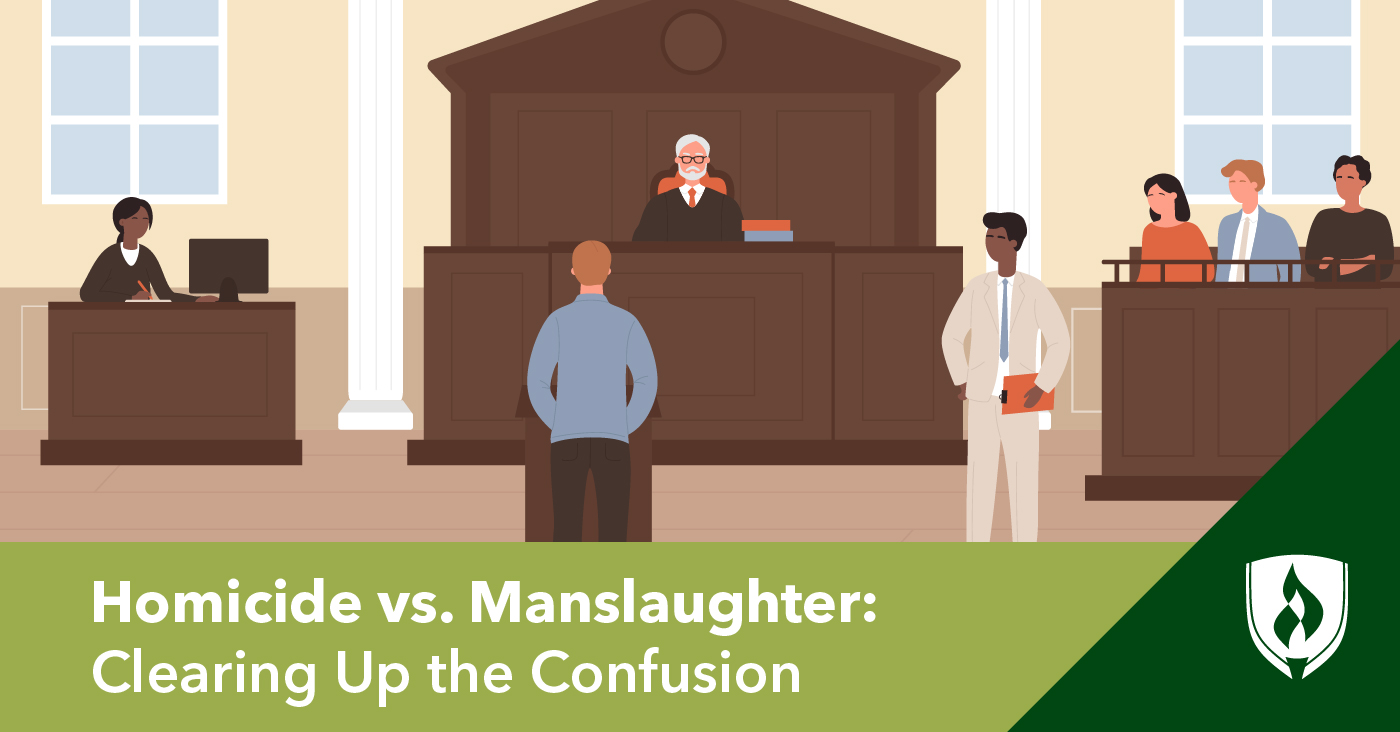
Murder is on the minds of many these days. As grim and foreboding as that statement may sound, there’s an innocent reason behind it. The “true crime” genre in recent years has experienced a huge surge in popularity, with podcasts, TV shows and films documenting every horrifying detail and intriguing clue.
But despite many falling down the criminal justice rabbit hole of learning about cold cases and infamous killers, there’s still quite a bit of confusion surrounding the legal terminology used in these cases. While they all might sound vaguely sinister, terms like “homicide”, “manslaughter” and “murder” are not as interchangeable as you might think.
While every state is different when it comes to specific definitions and statutes, these terms have specific definitions and conditions to be met when used in a legal setting. To help break down how these terms are typically defined in the courtroom, we asked legal experts to give guidance on how to think about these terms in general.
What is homicide?
At the most basic level, “homicide” is the most broadly applicable of these terms and functions more as a descriptor rather than as a legal statute or charge.
“Homicide’ refers to any and all instances when a person kills another,” says Nicholas B. Creel, assistant professor of accounting and business law at Georgia College and State University. “If you kill someone in self-defense, it’s still homicide, but it’s classified as an excused homicide.”
Another example of an excusable homicide happens in a military context.
“Soldiers in the battlefield commit homicide without committing a crime,” says David Reischer, attorney & CEO of Legal Advice.
The circumstances of the death are also a major factor in homicide.
“A homicide can also be murder or manslaughter and which one between the two will depend on the circumstances surrounding the act, such as the severity of execution of the act, as well as the perpetrator's state of mind before, during and after the killing,” says David Clark, attorney and partner of The Clark Law Office. “Correspondingly, all legally proven murders and manslaughters are homicides.”
What is manslaughter?
One of the distinctions between manslaughter and homicide involves planning and intention.
“Manslaughter’ is an unlawful killing that doesn't involve premeditation to seriously harm or kill a person,” says Reischer. “It is an extreme, reckless disregard for human life. Unintentional death, even as a consequence from a cyber-crime, could potentially be prosecuted for manslaughter if there is reckless conduct that causes the death of a person.”
Manslaughter is usually divided into two categories: voluntary and involuntary. Voluntary manslaughter is often something that is done impulsively.
“With voluntary manslaughter, we generally see it defined as the intentional killing of someone either in the heat of passion or with some form of significant provocation,” Creel says.
Recklessness and involvement in illegal activity at the time of the homicide are also common circumstances in manslaughter.
“They erred by committing the original crime which then led to a more heinous outcome, the loss of another person's life who wasn't involved and innocent,” explains Brian Joslyn, attorney at Joslyn Law Firm.
Involuntary manslaughter is when someone acts recklessly in a way that causes the death of another, owing to neglect or incompetence.
“Involuntary manslaughter usually means your actions or neglect led to another losing their life,” continues Joslyn. “There's even a misdemeanor involuntary manslaughter charge for such instances as vehicle accidents like failing to merge, improper left turn and so forth. They are accidents but they also resulted in death. The driver was not drunk or high, they were abiding by speed limits, but they still failed to exercise one small step that caused a bigger accident. These tend to not be jailable offenses, but they warrant the acknowledgment of the responsible party.”
What is murder?
Unlike homicide, murder is a legal statute and charge.
“A homicide is considered murder when the actor of the crime executed the crime with irrefutable intention to kill,” says Clark. “Situations, where the act of killing was committed due to a clear lack of respect for human life, are also murder. When the actor of the crime goes out of his way and kills another person unnecessarily, especially while committing another felony, such as robbery, which should have no need to take lives, also accounts for murder.”
Again, the degree of intention and planning, along with the circumstances in which the death occurred, all play roles in defining murder.
For example, if you are committing another crime, such as a robbery or an illegal drug transaction, and someone dies, this is also considered murder.
“Murder convictions can be brought if your participation in actions caused the death of another as a proximate result of attempting to commit a violent crime,” explains Joslyn.
First-degree murder is the most serious of the charges, as it factors in premeditation and organized planning. Second-degree murder can be confused with manslaughter, in that it is done in a moment of deep emotion.
Differences between voluntary manslaughter and second-degree murder
The distinctions between voluntary manslaughter and second-degree murder are often confusing. Both acts involve impulsive, heat-of-the-moment acts that are generally made through intense emotion. Attorney Ben Rose, of The Rose Firm, offers two examples.
If a person gets into a fight at a bar, and has intention to harm, but not to murder, this would constitute voluntary manslaughter.
“The presence or absence of malice at the time of the killing is key,” Rose explains.
However, if a person discovers their spouse has cheated on them and attacks and kills them in a rage, the presence of malice is much steeper, even if the decision is made quickly.
“Keep in mind that it doesn’t take much to constitute premeditation,” Rose adds. “Most people think that means ‘planning,’ but it can be very quick.”
As you can probably imagine, the distinction between these two can seem very blurry in some cases—prosecutors need to weigh all of the evidence available and will often need to make tough judgment calls for determining which charge is most likely to stick.
Get more legal facts
Though they can at times be complex and confusing, legal terms are a fascinating way to gain a better understanding of our social values and norms—and the legal system that serves as its guardrails. True crime narratives, in any format, offer a concrete way to understand the intentions of the justice system and the laws of the land. If reading through these legal distinctions has caught your interest, perhaps you’ll be interested in learning more details about other legal terms that pop up in other popular media. Check out our article “50 Courtroom Terms You Hear in Your Favorite Legal Dramas.”




